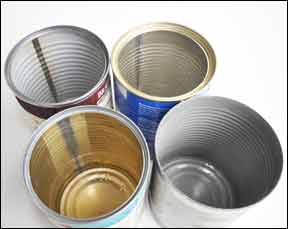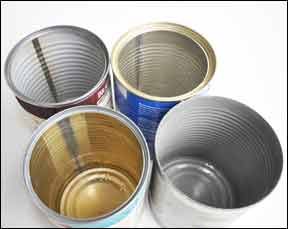On March 30, the U.S. Food and Drug Administration announced that it had rejected a petition from environmentalists that would have banned bisphenol A (BPA) from all food and drink packaging. The scientific evidence at this time, said the FDA, does not suggest that the “very low levels of human exposure to BPA” afforded through our diets are unsafe.

288
“The agency has performed extensive research on BPA, has reviewed hundreds of other studies, and is continuing to address questions and potential concerns raised by certain studies,” the news release continued. “The agency takes all concerns about BPA seriously and is evaluating them as part of the agency’s ongoing oversight of food safety.”
This release generated a tornado of disbelief, skepticism, and contempt from environmental and health activists, who frequently fear that BPA may be poised to kill all of us and our little dogs, too. In recent years, many pet owners have expressed concern about feeding canned food to dogs and cats due to the potential for exposure to BPA. How valid are these concerns?
What is BPA?
Bisphenol A was first synthesized (with acetone and phenol) by a Russian chemist in 1891. In the 1930s, the substance was found to have the ability to mimic human estrogen in the body, and it was tested as an estrogen replacement therapy for women. In the 1950s, chemists at Bayer and General Electric pioneered its use in plastic manufacturing; its ability to harden plastics – while retaining enough flexibility to keep the material from shattering – made it a wildly popular material.
Over the past 60 years, the industrial use of BPA has become pervasive in the human environment. In addition to its use as a microfilm lining inside food cans (preventing food from chemically interacting with the metal can), it’s used in plastic food and beverage containers, baby bottles, dental sealants, CDs and DVDs, medical equipment, sports equipment, eyeglass lenses and more. It’s also used to make carbonless copy paper and thermal paper – the kind used in many cash register and ATM receipts.
BPA readily enters our bodies via any contact we have with it. Humans ingest BPA that has leached into foods and beverages that are packaged with it. It can be absorbed through the skin by simple contact with products that contain it. (The amount found to be absorbed through the skin by briefly holding cash register receipts made with BPA is higher, in fact, than the amount that typically leaches into food and beverages from BPA-based packaging.) It also can enter the human body through respiration; studies have found BPA in soil and house dust.
BPA is rapidly metabolized and excreted by the body; its transit time in our bodies is quick. But it can be detected in about 95 percent of the population at any given time. This persistent test result demonstrates that we are subject to constant exposure to the substance.
Health Effects
Despite the fact that BPA has been known to be an estrogenic substance since the 1930s, no concerns were raised about its potential for causing health problems as an endocrine disrupter until 1997, when adverse effects of low-dose exposure to laboratory animals were first reported. It has been extensively studied since then, with the varied results one might expect from such a widely used product upon which so much industry relies. Some studies conclude that BPA at the currently accepted levels presents no threat to human health; others warn that the average levels found in humans are above those that cause harm in animals used in laboratory research.
In general, endocrine disrupters cause the greatest harm to animals in the earliest stage of their development, i.e., in utero and as infants. In 2006, a U.S. government panel of experts reviewed the scientific literature available on BPA and concluded that “BPA at concentrations found in the human body is associated with organizational changes in the prostate, breast, testis, mammary glands, body size, brain structure and chemistry, and behavior of laboratory animals.” (The U.S. Environmental Protection Agency considers exposures up to 50 µg/kg/day to be safe for humans. No limits for dogs or cats have been established.) Other studies have reported that BPA has adverse effects on thyroid hormone action.
BPA and Cans
Canned pet foods are probably one of the most likely sources of BPA in our dogs and cats (their diets are far less varied than ours).
Both steel and aluminum (the two most common can materials) must be lined with a barrier material to prevent interactions between the metal and food acids, enzymes, vitamins, minerals, and other substances. Once upon a time, tin was used to line steel cans; this wasn’t perfect, either, as it imparted a distinctive “tinny” taste to foods. But for the past 30-plus years, the liner of choice has been BPA. The North American Metal Packaging Alliance (NAMPA) boasts that since the complete industry adoption of BPA-based epoxy resin liners in food and beverage cans, there has not been a single incidence of foodbourne illness resulting from the failure of metal packaging. Unless you’re 40 or more years old, you may not even be aware that such a thing was possible!
This reliability would be terrific news, if only BPA didn’t leach into the consumable products it was supposed to protect. But it does get into the food, and scientists don’t even fully understand which chemical reactions are responsible; patterns that completely explain the wide range of BPA levels found in food and beverages do not exist. According to one FDA report, “Large variations in BPA concentrations were found between different products of the same food type and between different lots of the same product.” In other words, one brand of green beans may have high BPA levels while another brand of the same type of beans will have low levels. It’s even been observed that BPA levels can vary from lot to lot of the same product from the same brand.
The Search for a Reliable Alternative
According to NAMPA, the industry has made some progress in identifying alternatives to BPA, with four materials currently being explored: vinyl, acrylic, polyester, and oleoresins. The organization is not bursting with pride over any of these alternatives, though. “While each offers some of the needed characteristics for use as an interior can coating,” NAMPA states, “none of them meet all the performance and safety characteristics currently met by BPA-based epoxy resins . . . . Like BPA epoxy resin coatings, these coatings allow some migration of materials into the food product. Unlike BPA epoxy coatings, however, these alternatives have significant limitations.
“These other can coatings can impart odor and taste to the food product, have less flexibility, cannot withstand high temperatures required for sterilization, and compromise shelf-life, resulting in potentially higher costs and less choice to the consumer. For example, although often cited as the BPA-alternative of choice in the media, oleoresinous enamel is not viable for most food or beverage items. It represents a very small fraction of the overall canned vegetable market because of its limited performance.”
Companies that compete in the natural or holistic food niche have called the loudest for alternatives to BPA-based can liners. Eden Foods was a pioneer in this regard; about 10 years ago, when Mike Hall, the founder and president of Eden Foods, learned that oleoresinous enamels were used to line cans before the development of BPA, he asked his can suppliers to go back to that material. Until recently, BPA-based liners were still used for Eden’s tomato-based canned foods, because only BPA has been proven to resist deterioration caused by high-acid products. Eden finally gave up the wait for an alternative, though, and now packages all of its high-acid tomato-based products in glass jars.
Pet food companies (especially those that, like Eden Foods, are marketing “holistic and natural” products) are also begging canning material suppliers for alternatives to BPA-based liners. But safe and effective alternatives for pet food cans are simply not yet available. It’s proving much more difficult to find a reliable can liner for a chemically complex product like pet food than for vegetables. Dog and cat diets need to be “complete and balanced,” containing all the proteins, fats, vitamins, and minerals that our pets need. All of these ingredients, as well as the carriers, binders, thickeners, and other “functional” ingredients, have the potential for chemical interactions with the can liner. Formulating such a barrier material requires the testing of hundreds if not thousands of different chemical reactions. Many products have showed early promise, but failed “shelf life” tests.
Related Alternatives
Note that several of BPA’s close chemical relatives, including bisphenol A diglycidyl ether (usually abbreviated as BADGE but sometimes seen as DGEBA), bisphenol F, bisphenol F diglycidyl ether (abbreviated as BFDGE), and bisphenol sulfonate (bisphenol S), are also used for lining food and beverage cans; these other products are more frequently used on aluminum cans.
Today, almost all small cans – those that hold 3 to 5.5 ounces of wet food – are made of aluminum and lined with either BADGE or BFDGE. These cans are stamped out of a sheet of aluminum and don’t require a welded seam on one side the way steel cans do. A stronger material than aluminum, steel is used for larger cans, and BPA is still considered the most reliable coating for steel. If another coating is used in a steel can, the welded seam is almost always coated with a strip of BPA, and then the alternative coating is applied over that.
Unfortunately, like BPA, all of these chemicals are estrogenic, and all of them have demonstrated their ability to leach into food and beverages. Further, even less is known about these newer chemicals than about BPA.
Marketing
The lack of BPA-alternatives for safe, reliable canned pet food liners hasn’t kept pet food companies from attempting to competitively describe and market their products. We’ve seen companies describe their use of BPA as minimal, miniscule, or “less than the amount allowed by the FDA.” Some say that they have “discontinued the use of BPA” in their small cans or that “our small cans are already BPA-free.” They may state they “are actively seeking out alternatives to BPA,” “testing substances to replace BPA,” or “phasing out BPA” as soon as they can find a feasible alternative. (Campbell’s Soup recently made national headlines with this last claim.)
The thing is, all of these statements could be said by any maker of canned foods, and they all mean the same thing. Virtually all canneries use only a small amount of BPA-based can lining material, it all leaches less than what the FDA allows, and the entire industry is frantically researching and testing alternatives.
Watch also for statements to the effect that “our raw can materials” or the cans themselves have no BPA. Technically, these statements are true of every can, too; it’s the can liners that contain BPA. Tricky!
Decision Time
As the FDA recently stated, it’s not clear that the amount of BPA present in our (or our pets’) diet is a certain health hazard. But for some pet owners, the decision to avoid this particular chemical exposure is easy; they don’t or won’t feed canned food to their pets.
That’s fine if their alternative to canned food is a fresh home-prepared or commercial frozen diet. But it would be unfortunate for pets whose owners won’t use these alternatives and who would benefit from a wet diet, such as dogs with kidney disease, senior dogs with poor appetites, and all cats (researchers are starting to suspect that many feline health problems are due to eating dry food). And given the ubiquity of this chemical in the modern environment, one can’t even be assured that avoiding canned foods will prevent your pet’s exposure to BPA.







just wanted to say how much i greatly appreciate your article. i was always curious if pet food cans were bpa free since the canadian government “banned” the chemical. I looked this up tonight because i had been letting my dogs lick out the small pull tab cat tins and just wondered. so now i am worried about buying large cans of dog food like i used to, from a local chilliwack dog food company called Tri naturals and their other brand Lean cuts. This was the most affordable canned dog food besides pedigree. I used to feed dehydrated raw and might look into that again but i had a question… what about the plastic canned dog food with the tin foil lids? are those also dangerous? I assume they’re much safer if the plastic base is recyclable material, i’ll have to check the “number” on the bottom next time. and I assume the glue for the tinfoil lid doesn’t leech into the food since it’s on the ledge? but then i wonder how do they cook or pressure-cook these? the meat is cooked inside the plastic? that doesn’t sound healthy to me, i just have a hunch that it leeches. so is my safest bet (if not making my own dog food) just buying the tiny small dog food cans? and does it make a difference if it is a pull tab or not? thank you for your time and consideration